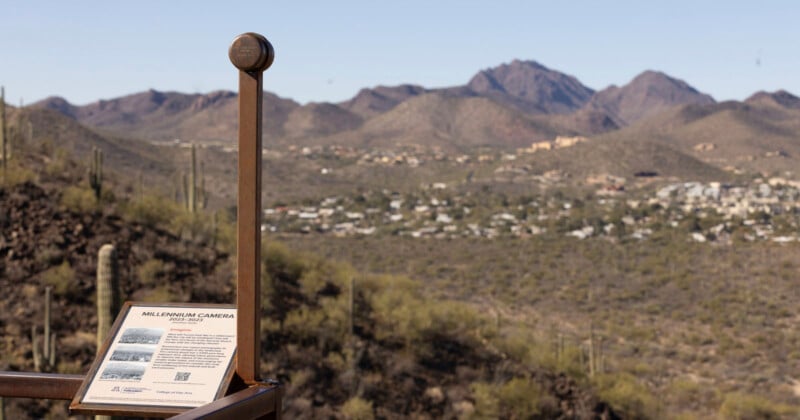The ‘Millennium Camera’ Will Capture Arizona’s Landscape for 1,000 Years

| Photo Credit: Christopher Richards, University Communications
Standing watch over the desert landscape of Tuscon, Arizona for the next 1,000 years, the aptly named Millennium Camera is designed to slowly capture the changing scene in front of it until the year 3023.
An experiment organized by University of Arizona research associate and experimental philosopher Jonathan Keats, the Millennium Camera is meant to record an extremely long-exposure image that won’t be complete for 10 decades.
The concept of the camera isn’t too far removed from the beer can camera that Regina Valkenborgh set up at the Bayfordbury Observatory in the United Kingdom in 2012. In that case, the pinhole-style camera was in place for eight years and one month and captured what was at the time believed to be the longest exposure photo ever made.
If it works as planned, Keats’ Millennium Camera will have that record beat by more than 100 fold. It uses a similar pinhole design as Valkenborgh’s beer can camera but has elements made to extend the time the camera will operate. That pinhole is leads to a thin sheet of 24-karat gold that will slowly let light through to a small copper cylinder mounted on top of a steel pole. Over the course of 1,000 years, the landscape in front of the pinhole camera will slowly fade a light-sensitive surface that is coated in thin layers of rose madder (an oil paint pigment), The University of Arizona explains.
In 10 centuries, future humans will hopefully be able to open the Millennium Camera to reveal a long exposure image of the area through all of the changes Tuscon will undergo. That is, of course, the hope anyway.
![]()
“One thousand years is a long time and there are so many reasons why this might not work,” Keats says. “The camera might not even be around in a millennium. There are forces of nature and decisions people make, whether administrative or criminal, that could result in the camera not lasting.”
If it does work, however, Keats says that the final image will likely show the longest-lasting features — like mountains and rocks — sharpest while the most dynamic parts such as the city itself will be softer. “Sharp” is also used loosely, as the land itself is not completely stable and will experience subtle motion over the extended exposure time.
“Let’s take a really dramatic case where all the housing is removed 500 years in the future,” Keats adds. “What will happen then is the mountains will be clear and sharp and opaque, and the housing will be ghostly. All change will be superimposed on one image that can be reconstructed layer by layer in terms of interpretation of the final image.”
The Millennium Camera is currently installed on Tumamoc Hill next to a bench that faces west over the Star Pass neighborhood of Tuscon. With it is a small plaque that encourages visitors to imagine what the future holds.
![]()
“Most people have a pretty bleak outlook on what lies ahead,” Keats says.
“It’s easy to imagine that people in 1,000 years could see a version of Tucson that is far worse than what we see today, but the fact that we can imagine it is not a bad thing. It’s actually a good thing, because if we can imagine that, then we can also imagine what else might happen, and therefore it might motivate us to take action to shape our future.”
The Millennium Camera is, then, as much about leaving a record for future people as it is meant to provide the people of the present a philosophical touch point. Its mere existence is designed to encourage people to think about the future and the world that is being left to it.
“By no means is the camera making a statement about development — about how we should build the city or not going forward,” Keats says.
“It is set there to invite us to ask questions and to enter into conversation and invite the perspective of future generations in the sense that they’re in our minds.”
To that end, Keats is steadfast in his belief that the camera should not be opened ahead of the 3023 mark.
“If we open in the interim, then it diminishes the imagining that we need to be doing.”
Image credits: Christopher Richards, University of Arizona Communications Department